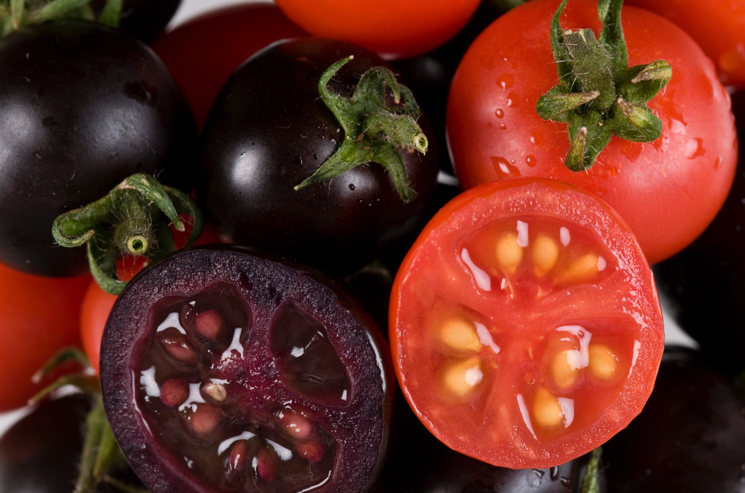 Plant Biology
Plant Biology
Improving the dietary value of tomatoes with purple plant pigments
Obtaining the right daily amount of fresh food is a challenge in many countries. This study improved the dietary value of tomato, by enhancing the content of a beneficial plant pigment, called anthocyanin. Tomatoes enriched in anthocyanins had purple-coloured fruit, and improved the lifespan of mice. Increasing the nutritional value of tomato is promising for improved public health.

Numerous countries have deployed public health campaigns to promote consumption of five or more serving of fruit and vegetables per day, aimed to improve health outcomes. However, recent data suggests these campaigns were not effective, as the mean daily consumption of fruit and vegetables was 3.91 servings in certain countries. In the study described here, the research team aimed to improve the dietary value of tomatoes, a widely consumed vegetable, by increasing the content of anthocyanins, specifically in the fruit. Anthocyanins are group of pigments made by plants, that confer purple, pink and blue shades to flowers and fruit. Anthocyanins obtained from consumption of fresh fruit and vegetables in our diets can function as antioxidants, acting to protect our cells from certain types of damage.
Here, the researchers developed a new variety of tomato that included two genes that were already known to promote anthocyanin production in snapdragon flowers (Antirrhinum majus). In the new variety, these two genes are active only during the tomato fruit ripening process. The result of this was an accumulation of anthocyanins throughout the entire fruit, giving rise to an intense purple colour of the tomatoes upon ripening.
Since the new purple tomato variety showed a massive accumulation of anthocyanins, the researchers wanted to know if this trait could impart any beneficial effects in a dietary context. To test this, a strain of mice susceptible to cancer were fed three different types of diet. The control group were fed regular mouse food. The two test groups were fed regular mouse food supplemented with extracts from tomatoes - one group with normal red tomato extracts, while the third group received food supplemented with extracts from the new purple tomatoes. The lifespan of the mice fed the three different diets was followed. Mice fed the control diet had an average lifespan of 142 days. Animals fed the diet supplemented with the normal red tomatoes showed a similar lifespan to the control group (average 145.9 days). Strikingly, mice fed the diet supplemented with purple tomatoes had a significantly longer lifespan (in mouse terms) of 182.2 days on average, with the oldest mouse living for 260 days. The increased anthocyanin content in the purple tomatoes clearly had a dramatic effect on the physiology, and therefore lifespan, of these mice.
This is all very well, however, you might be wondering "why all the fuss?" when there are already varieties of tomatoes available with purple fruit, such as Indigo Rose. The difference is that in varieties like Indigo Rose, the anthocyanin accumulation is restricted solely to the skin - which makes up only about 5 % of the fresh weight of the fruit. Indigo Rose tomatoes have about 0.1-0.3 mg of anthocyanins per gram of fresh weight. In contrast, the tomatoes developed in this study had anthocyanins distributed throughout the flesh and skin, giving rise to up to 2.83 mg (± 0.46) per gram of fresh weight - nearly 28 times more than Indigo Rose. Anthocyanins are otherwise absent from red-fleshed tomato varieties. A much higher intake of the beneficial anthocyanins might therefore be obtained from the tomatoes described in this study.
An additional benefit subsequently discovered with the purple tomatoes developed in the study is a prolonged shelf life and resistance to certain moulds. Collectively, the potential benefits to consumers of these purple tomatoes include both potentially improved health and reduced wastage from spoilage. This study highlights the usefulness of improving the dietary value of widely-consumed plants, and awaits studies in humans to confirm its efficacy.
Original Article:
E. Butelli et al., Enrichment of tomato fruit with health-promoting anthocyanins by expression of select transcription factors. Nat Biotechnol 26, 1301-1308 (2008)Next read: Driving down malaria by Andrew Hammond , Xenia Karlsson , Ziyin Wang
Edited by:
Massimo Caine , Founder and Director
We thought you might like
A Weekend Camping is Just What the Doctor Ordered
Jun 21, 2017 in Health & Physiology | 4 min read by Hannah Kent Ritchie , Ellen R. Stothard , Kenneth P. WrightChildren Prefer the Real Thing to Pretending
Mar 1, 2018 in Psychology | 3 min read by Angeline Lillard , Jessica TaggartOne million (paper) satellites
Jan 24, 2025 in Earth & Space | 3 min read by Ewan Wright , Andrew FalleChemotherapy and heart failure
Mar 25, 2024 in Health & Physiology | 2.5 min read by Hector Villarraga , Mariana Garcia ArangoMore from Plant Biology
Unravelling the Secrets of Pine Roots: A Tale of Nutrition and Adaptation
Oct 20, 2023 in Plant Biology | 3.5 min read by Rafael Cañas , Francisco OrtigosaStressful memories help plants resist caterpillars
Oct 2, 2023 in Plant Biology | 3.5 min read by Samuel Wilkinson , Adam Hannan Parker , Jurriaan TonDecoding the genome of a jackfruit that grows all year round
Sep 6, 2023 in Plant Biology | 3.5 min read by Tofazzal IslamLife after logging: the tale of recovering tropical forests
Aug 21, 2023 in Plant Biology | 3.5 min read by Maria Mills , Terhi RiuttaEditor's picks
Trending now
Popular topics


